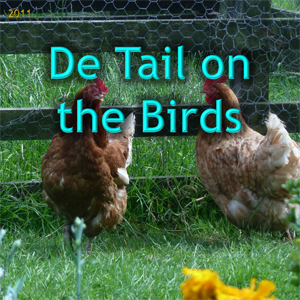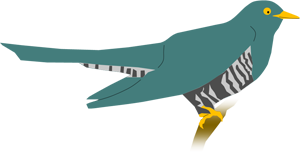 Article for 2011 Apr 30
Article for 2011 Apr 30
Part of the “De Tail on the Birds” series.
2011
Appendix

This was a monthly series of articles each focussing on a particular avian species I find interesting, though “Caledonia Gulls” features several species and is in poem form.
Apr 30 Sat “The cuckoo clocked”
The bird I’ll clock in this essay is the cuckoo, Cuculus canorus, which I’ve no photos of because I’ve never seen one. I have however sometimes heard male cuckoos calling from deep inside forests. Indeed, cuckoos are called “cuckoos” after their distinctive and famous call, which I think sounds more like “fl-whuh-hoo”.
The cuckoo’s call has also inspired its scientific name Cuculus canorus. Cuculus is the Latin word for “cuckoo” (don’t confuse it with “cumulus”, which means “heap” in Latin and is a type of cloud in English). And canorus is Latin for “melodious”, from cano “I make music”.
I chose to write about the cuckoo in April 2011 because April is a common time for cuckoos to start arriving in Britain (they’re seasonal migrants) and start calling.
Then, while researching for this article, I discovered some interesting Celtic folklore relating to cuckoos. Cuckoos used to be known as “gowks” in Britain, pronounced like “gowns”, but with a “k” sound rather than a “n”. In Scotland, a traditional custom was to celebrate Gowk’s Day on the 13th day of April (this month), which involved playing pranks on children, like modern April (this month) Fool’s Day. (The word “gowk” also meant “fool”.) Around Gowk’s Day, cuckoos were supposed to start arriving, landing on various special “Gowk’s Stones” in Scotland and Ireland.
“Gowks” were also believed to be able to cause death, bad storms, and Spring. (There are often storms in Spring.) Gowks could also predict the dates of weddings (is that why Prince William and Kate Middleton are getting married this month?).
In 1066, the French term coucou - the conquering Normans were, of course, French - became popular in Britain, later displacing “gowk” in most areas and evolving into the modern term “cuckoo”. The bird’s association with fools was retained though, surviving in the modern usage of “cuckoo” as an adjective to mean “insane”, and in the word “cloudcuckooland” which means the place where insane people live. Apparently the word “gowk” is sometimes used in Scotland and Northern England.
Anyway, back to biology. Both genders usually look similar: dove-sized (33cm long) with a slender body and long tail rectangular tail which is splayed during courtship; cuckoos are sometimes mistaken for falcons such as peregrines. A cuckoo is grey with a hint of brown, except for its underside, which is white and striped with thin grey wobbly lines, like a sparrowhawk. The eyes and beak are yellow.
The cuckoo, as well as being well-known for its call and Spring arrival, are famous (or infamous) for not bothering to build its own nest, instead laying its egg in another bird’s nest, for the other bird to look after. The nests and young of dunnocks, reed warblers, and meadow pipits are usually hijacked in this way. After hatching, the cuckoo chick pushes the chicks that aren’t cuckoos out of the nest, being the size of three adult reed warblers so needing/wanting all the food that the deceived adult bird brings. Cuckoo chicks are able to mimic the cries of dunnock/warbler/pipit chicks very well, so the adult bird probably never realises that that fat grey ball of hungry chick is not its offspring.
The first surviving written account of the cuckoo’s egg-laying habits was by the Greek philosopher Aristotle. Over two millenia later, in 1788, Edward Jenner earned the honourable title of “Fellow of the Royal Society” for his observations of cuckoo behaviour; afterwards, he successfully vaccinated people against deadly smallpox: he’s still famous today. Not as famous as those German automated time-pieces, though.
